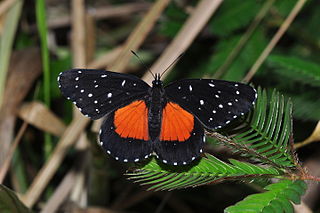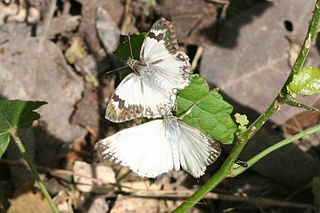
Chlosyne janais, the crimson patch or janais patch, is a common New World butterfly found from Colombia north through Central America and Mexico to southern Texas, with occasional sightings in southeastern Mexico and northern Texas. The dorsal and ventral wing surface is black with several undulating rows of small white spots on the medial forewings and along all outer wing margins. On each dorsal hindwing is a medial orange-red patch situated anteriorly. The ventral hindwings have a fragmented yellow proximal patch bordered by a thick postmedial band of red that does not reach the wing margins; maximum wingspan is 4.8–6.7 cm.

Burnsius philetas, the desert checkered-skipper, formerly known as Pyrgus philetas, is a species of skipper butterfly in the family Hesperiidae. It is found from the southern United States (southern Arizona east to southern Texas, and to southern Mexico. Individuals are also found north to northern Arizona and northern Texas.

Amblyscirtes celia is a butterfly of the family Hesperiidae. It is found from Texas, south to north-eastern Mexico. Strays to south-western Louisiana.

Amblyscirtes vialis is a butterfly of the family Hesperiidae. It is found from British Columbia east across southern Canada to Maine and Nova Scotia, south to central California, northern New Mexico, Texas, the Gulf states and northern Florida.

Lerodea eufala, the Eufala skipper or rice leaffolder, is a species of butterfly in the family Hesperiidae. It is found from the coast of Georgia, south through Florida and west across the southern United States to southern California, south through Mexico and Central America to Patagonia. In the summer, it expands its range north to central California, North Dakota, southern Wisconsin, northern Michigan and Washington, D.C.

Anthanassa frisia, the Cuban crescentspot, Cuban checkerspot or Cuban crescent, is a butterfly of the family Nymphalidae. Subspecies tulcis is known by the common names pale-banded crescent or Tulcis crescent; it is treated as a species by some authors.

Zizula cyna, the cyna blue, is a butterfly species in the family Lycaenidae.

Calpodes ethlius, the Brazilian skipper, larger canna leafroller or canna skipper, is a butterfly of the family Hesperiidae. It is found in the United States from southern Florida and southern Texas, south through the West Indies, Mexico, and Central America to Argentina. Strays and temporary colonies can be found north to southern Nevada, northern Texas, Illinois and Massachusetts.

Wallengrenia otho, the southern broken dash or broken dash skipper, is a butterfly of the family Hesperiidae. It was originally described by Smith in 1797. It is found from eastern Texas and the southeastern United States, south through the West Indies and Central America to Argentina. Strays can be found as far north as central Missouri, northern Kentucky and Delaware.

Texola elada, the Elada checkerspot, is a species of butterfly in the brush-footed butterfly family, Nymphalidae. It is found from southern Mexico north to central Texas and central Arizona in the United States.

Phocides polybius, the bloody spot or guava skipper, is a species of butterfly in the skipper family, Hesperiidae, that is native to the Americas. It is found from the lower Rio Grande Valley of southern Texas in the United States south through Mexico and Central America to Argentina. The species was first described by Johan Christian Fabricius in 1793.

Cecropterus dorantes, the lilac-banded longtail or Dorantes longtail, is a species of butterfly in the family Hesperiidae. It is found from Argentina, north through Central America, Mexico, and the West Indies to southern Texas and peninsular Florida. Strays can be found as far north as northern California, southern Arizona, southern Missouri and North Carolina.

Pellicia arina, the glazed pellicia, is a butterfly of the family Hesperiidae. It is found from Panama north through Central America to northern Mexico. Rare strays are found up to the lower Rio Grande Valley in Texas.

Timochares ruptifasciatus, the brown-banded skipper, is a butterfly of the family Hesperiidae. It is found in southern Texas, Mexico and Jamaica.

Chiothion asychis, the white-patched skipper or white patch, is a species of butterfly in the family Hesperiidae. It is found from Argentina, north through tropical America to the West Indies and southern Texas. Strays can be found as far north as southern Arizona, Nevada and Kansas.

Heliopetes macaira, the Turk's-cap white-skipper , is a butterfly of the family Hesperiidae. It is found from southern Texas in North America, south through Central America to Paraguay.

Ganyra josephina, the giant white, is a butterfly in the family Pieridae.

Rekoa marius, the Marius hairstreak, is a butterfly in the family Lycaenidae. It is found from Paraguay north to Sonora in Mexico. Strays may be found as far north as southern Texas. The species used to be considered rare in the southern Texas. It is the species of Rekoa found in Arizona. The habitat consists of disturbed tropical areas.

Anthanassa texana, the Texan crescentspot, is a species of butterfly in the family Nymphalidae. It is found from Guatemala north through Mexico to southern California, east across the southern United States to northern Florida, Georgia and South Carolina. Strays may be found up to Arkansas, Missouri, Illinois, South Dakota, and central Nevada. The habitat consists of deserts, dry gulches, open areas, streamsides, road edges, and city parks.

Heliopetes laviana, the Laviana white-skipper or Laviana skipper, is a butterfly in the family Hesperiidae. It is found from Argentina through Central America and northern Mexico to southern Texas. Strays can be found in southern Arizona and central and northern Texas. The habitat consists of edges of brushy areas, trails, roadsides, open woodland, thorn forest and streamsides.




















